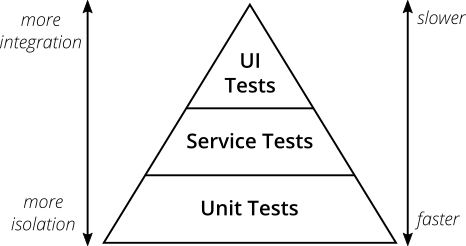Testing
 Common Questions on Testing
Common Questions on Testing
What is Software Testing
Software testing is a procedure to investigate the quality of a software product in different scenarios. It can also be stated as the process of verifying and validating that a software program or application works as expected and meets the business and technical requirements that guided design and development.
Why Software Testing
Software testing is required to point out the defects and errors that were made during different development phases. Software testing also ensures that the product under test works as expected in all different cases – stronger the test suite, stronger is our confidence in the product that we have built. One important benefit of software testing is that it facilitates the developers to make incremental changes to source code and make sure that the current changes are not breaking the functionality of the previously existing code.
What is TDD
TDD stands for Test Driven Development. It is a software development process that relies on the repetition of a very short development cycle: first the developer writes an (initially failing) automated test case that defines a desired improvement or new function, then produces the minimum amount of code to pass that test, and finally refactors the new code to acceptable standards. The goal of TDD can be viewed as specification and not validation. In other words, it’s one way to think through your requirements or design before your write your functional code.
What is BDD
BDD stands for “Behaviour Driven Development”. It is a software development process that emerged from TDD. It includes the practice of writing tests first, but focuses on tests which describe behavior, rather than tests which test a unit of implementation. This provides software development and management teams with shared tools and a shared process to collaborate on software development. BDD is largely facilitated through the use of a simple domain-specific language (DSL) using natural language constructs (e.g., English-like sentences) that can express the behavior and the expected outcomes. Mocha and Cucumber testing libraries are built around the concepts of BDD.
 Testing workflow
Testing workflow

(Ref: Ham Vocke, The Practical Test Pyramid)
We follow a testing workflow in accordance with the test pyramid diagram given above, starting with isolated tests and moving towards complete integration for any new feature changes. The different types of tests (in the order that they should be performed) are explained below:
Unit Tests
Unit testing is a level of software testing where individual units/ components of a software are tested. The objective of Unit Testing is to isolate a section of code and verify its correctness.
Ideally, each test case is independent from the others. Substitutes such as method stubs, mock objects, and spies can be used to assist testing a module in isolation.
Benefits of Unit Testing
- Unit testing increases confidence in changing/ maintaining code. If good unit tests are written and if they are run every time any code is changed, we will be able to promptly catch any defects introduced due to the change.
- If codes are already made less interdependent to make unit testing possible, the unintended impact of changes to any code is less.
- The cost, in terms of time, effort and money, of fixing a defect detected during unit testing is lesser in comparison to that of defects detected at higher levels.
Unit Tests in DTaaS
Each component DTaaS project uses unique technology stack. Thus the packages
used for unit tests are different. Please check the test/ directory of
a component to figure out the unit test packages used.
Integration tests
Integration testing is the phase in software testing in which individual software modules are combined and tested as a group. In DTaaS, we use an integration server for software development as well as such tests.
The existing integration tests are done at the component level. There are no integration tests between the components. This task has been postponed to future.
End-to-End tests
Testing any code changes through the end user interface of your software is essential to verify if your code has the desired effect for the user. End-to-End tests in DTaaS a functional setup.
There are end-to-end tests in the DTaaS. This task has been postponed to future.
Feature Tests
A Software feature can be defined as the changes made in the system to add new functionality or modify the existing functionality. Each feature is said to have a characteristics that is designed to be useful, intuitive and effective. It is important to test a new feature when it has been added. We also need to make sure that it does not break the functionality of already existing features. Hence feature tests prove to be useful.
The DTaaS project does not have any feature tests yet. Cucumber shall be used in future to implement feature tests.
References
- Arthur Hicken, Shift left approach to software testing
- Justin Searls and Kevin Buchanan, Contributing Tests wiki.
- This wiki has good explanation of TDD and test doubles.